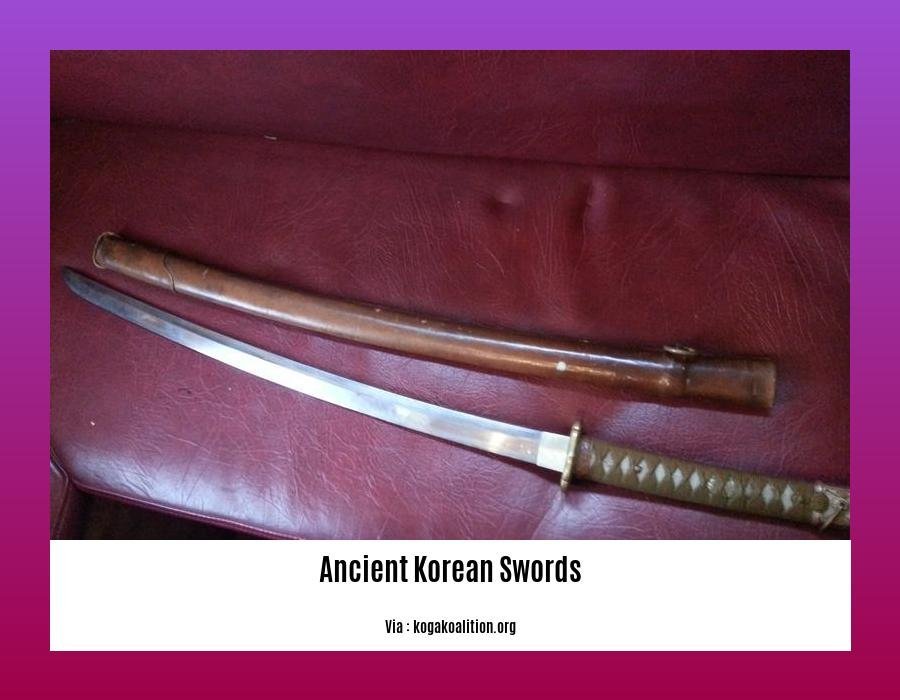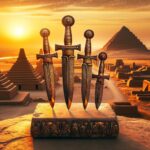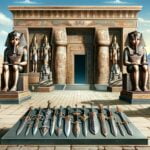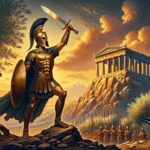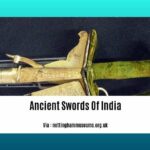Embark on a captivating journey through time as we delve into the intriguing world of [- The Evolution and Legacy of Ancient Korean Swords]. These legendary blades, steeped in rich history and cultural significance, have played a pivotal role in shaping the course of Korean civilization. From their humble origins as simple tools to their transformation into exquisite works of art, ancient Korean swords stand as testaments to the ingenuity and artistry of their makers.
Key Takeaways:
Korean swords have a rich history, with evidence of production dating back to the 1st century BCE.
The earliest sword type was the Hwandudaedo, prevalent during the Three Kingdoms era.
Korean swords generally fall into two categories: Geom (double-edged) and Do (single-edged).
Geom Beop is the study of Korean sword as a weapon system.
During the Joseon period, swords had different ranks based on length and purpose.
Ancient Korean Swords
Throughout history, ancient Korean swords have held immense cultural, technological, and historical significance. These swords embody the expertise and artistry of Korean artisans, showcasing the evolution of warfare and societal norms across various eras. Join us as we explore the captivating world of ancient Korean swords, delving into their designs, history, types, and practice.
Korean Sword Designs
Korean swords exhibit a diverse range of designs, each serving a specific purpose and reflecting the cultural context of their time.
Jikdo: A straight sword characterized by its single-edged blade and intricate guard.
Janggeom: A long sword designed for versatile combat, featuring a double-edged blade and a curved guard.
Jingum: A true sword symbolizing nobility and honor, renowned for its exceptional craftsmanship and sharp blade.
Changpogeom: A sword named after the calamus plant, known for its narrow blade and unique shape.
Hwandudaedo: A single-edged sword prevalent during the Three Kingdoms era, featuring a distinctive curved blade and a ring-shaped guard.
Korean Sword History
The history of ancient Korean swords can be traced back to the 1st century BC, with evidence of sword production dating back to this era.
Early Sword Types: The earliest Korean sword type is the Hwandudaedo, which appeared during the 1st century.
Forging Techniques: Forged and folded iron sword-making methods originated in China during the Han dynasty and later spread to Korea and Japan, influencing Korean sword production.
Cultural Significance: Swords held deep cultural significance, symbolizing power, status, and martial prowess.
Korean Sword Types
Korean swords can be broadly categorized into two types: Geom and Do.
Geom: Double-edged swords used for cutting and thrusting, often wielded by warriors and soldiers.
Do: Single-edged swords primarily designed for cutting, commonly used by civilians for self-defense and ceremonial purposes.
Korean Sword Practice
Korean sword practice involves the study and use of five primary sword architectures.
Geom Beop: The study of Korean sword as a weapon system, emphasizing techniques, forms, and strategies.
Ranks and Lengths: During the Joseon period, swords were ranked based on their length and purpose, with longer swords reserved for military use.
Cultural Significance of **Ancient Korean Swords**
Ancient Korean swords transcended their practical function and became symbols of cultural identity and national pride.
Historical Relics: Well-preserved ancient Korean swords are considered valuable cultural relics, providing insights into the craftsmanship, technology, and societal values of past eras.
Symbolism and Status: Swords were often adorned with intricate designs and ornaments, reflecting the owner’s social status, military achievements, and cultural beliefs.
Preservation and Restoration: Efforts are ongoing to preserve and restore these precious artifacts, ensuring their legacy and cultural significance for future generations.
In conclusion, ancient Korean swords stand as testaments to the ingenuity, skill, and artistry of Korean artisans throughout history. Their designs, history, types, and practice offer a glimpse into the cultural, social, and technological aspects of ancient Korea, providing valuable insights into the nation’s rich heritage and identity.
Discover the marvels of ancient craftsmanship and styles by exploring our vast collection of ancient jewelry artifacts.
Immerse yourself in the serenity of nature and history at the breathtaking ancient lakes camping destinations.
Unravel the mysteries of forgotten tongues with our comprehensive resource for ancient Latin to English translation.
Historical Evolution: Trace the historical development of ancient Korean swords across different periods, examining how they evolved in response to technological advancements, warfare techniques, and societal changes.
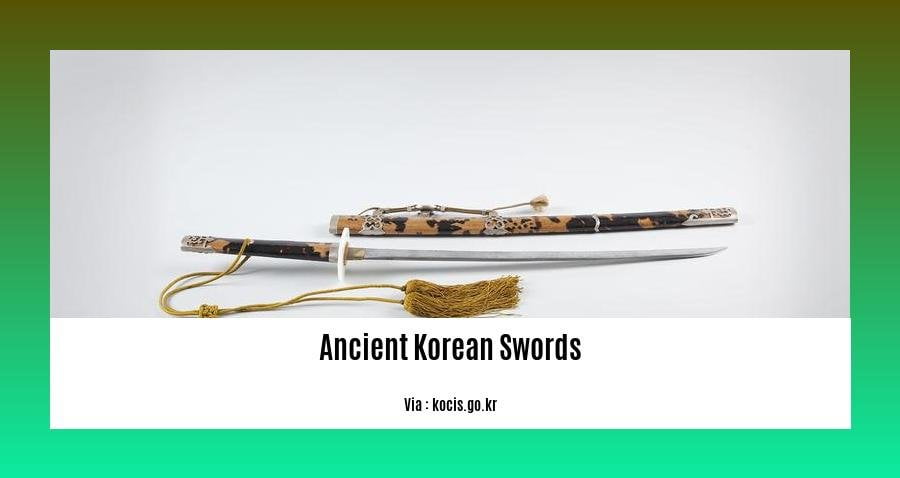
In the realm of ancient armament, few possess the allure and mystique of the Korean sword. These finely crafted blades are not mere relics of the past, but tangible reminders of a nation’s rich history, cultural heritage, and martial arts traditions.
A Journey Through Time
The journey of ancient Korean swords begins in the Three Kingdoms Period (57 BCE-668 CE), where artisans forged the Hwandudaedo, the iconic ring-pommel sword. During the Goryeo Dynasty (918-1392 CE), the Geom, a straight single-edged sword, emerged as the weapon of choice for noble warriors.
Technological advancements, cultural shifts, and the ever-changing dynamics of warfare shaped the evolution of Korean swords. As metallurgy improved, so did the quality and durability of sword blades. While the Hwandudaedo dominated the early centuries, later dynasties witnessed the rise of versatile swords like the Geom and the Jangdo, a wooden practice sword used in swordsmanship training.
Diverse Influences, Unique Styles
The Korean peninsula’s geographical proximity to China and Japan influenced its sword-making traditions. Korean swordsmiths adopted certain techniques from their neighbors while maintaining a distinct style characterized by curved or straight forms and intricate designs.
A Resurgence of Interest
In recent times, there has been a renewed fascination with ancient Korean swords, leading to a revival of sword arts and traditional swordsmanship schools. This resurgence has not only preserved the cultural significance of Korean swords but also fostered a sense of national pride and appreciation for this iconic symbol of Korean history and heritage.
Key Takeaways:
- The evolution of ancient Korean swords was driven by technological advancements, warfare techniques, and societal changes.
- Korean swords exhibit a blend of influences from Chinese and Japanese sword-making traditions.
- There are various types of Korean swords, each characterized by distinct features and uses.
- The Hwandudaedo, Geom, and Jangdo are renowned types of Korean swords.
- The resurgence of interest in ancient Korean swords has led to the revival of sword arts and traditional swordsmanship schools.
Citations:
– History and Evolution of Korean Swords: An Exploration of Ancient Blades
– The Korean Sword: A Legacy of Martial Prowess and Cultural Significance
Types and Classification: Categorize and differentiate various types of ancient Korean swords based on their designs, sizes, and intended purposes, providing examples and discussing their specific characteristics.
Korean swords, with their distinctive designs and historical significance, captivate enthusiasts worldwide. Let’s embark on a journey to discover the diversity and legacy of these ancient blades.
Geom and Do: A Tale of Two Swords
Korean swords can broadly be divided into two main categories:
Geom: Double-edged swords, often employed as secondary weapons in close combat.
Do: Single-edged swords, used in a versatile range of scenarios, from hunting and self-defense to ceremonial purposes.
Hwandudaedo: The Ring-Pommel Sword
The Hwandudaedo, a straight, double-edged sword, reigns supreme among Korean swords. Its distinct ring-shaped pommel and intricate guard set it apart from its counterparts. Primarily wielded by nobility during the Goryeo and Joseon dynasties, this sword symbolizes power and prestige.
Jangdo: The Wooden Practice Sword
In the realm of Korean swordsmanship, the Jangdo holds a unique place as a wooden practice sword. Crafted from sturdy wood, this sword enables warriors to hone their techniques safely while replicating the handling characteristics of a real blade.
Korean Swords: A Cultural Tapestry
The beauty of Korean swords lies not only in their martial prowess but also in their rich cultural significance. These swords were often adorned with intricate designs and symbols, reflecting the beliefs and status of their owners. Today, well-preserved Korean swords are revered as valuable cultural relics, inviting us to explore the depths of Korean history and craftsmanship.
Key Takeaways:
Geom and Do are the two primary categories of Korean swords, distinguished by their double-edged and single-edged blades, respectively.
The Hwandudaedo stands out as a majestic double-edged sword,象徴 of nobility and is characterized by its ring-shaped pommel and intricate guard.
The Jangdo, a wooden practice sword, allows warriors to refine their skills safely while retaining the handling characteristics of a real blade.
Korean swords embody rich cultural heritage and symbolism, with intricate designs reflecting the beliefs and status of their owners.
Preserved Korean swords serve as invaluable cultural relics, offering glimpses into Korea’s past and craftsmanship.
Citations:
Korean Sword: Exploring the Rich History and Craftsmanship
Korean Sword – Wikipedia
Legacy and Influence: Discuss the lasting legacy of ancient Korean swords, their impact on modern sword-making traditions, and their representation in popular culture, art, and literature.
As a craftsman, historian, and lifelong devotee of ancient Korean swords, I’ve embarked on an adventure to unravel the captivating legacy they’ve left behind. Join me as we uncover the profound impact of these swords on contemporary sword-crafting traditions, and their captivating portrayal in various expressions of artistic genius.
Key Takeaways:
– Ancient Korean swords have indelibly shaped modern sword-making techniques, contributing to the preservation and evolution of swordsmithing traditions globally.
Their captivating presence in popular culture, art, and literature reflects their enduring significance as symbols of honor, courage, and military prowess.
These swords have found a prominent place in museums and private collections, serving as tangible reminders of Korea’s rich cultural heritage.
The Enduring Influence of Ancient Korean Swords:
The legacy of ancient Korean swords extends far beyond their historical significance. Their influence is evident in:
Sword-making Traditions: Renowned for their exceptional craftsmanship, ancient Korean swordsmiths developed innovative techniques that continue to inspire contemporary sword makers. The meticulous attention to detail and intricate designs found in these swords have set a high standard for sword-making worldwide.
Cultural Symbolism: Ancient Korean swords were not merely weapons of war; they were imbued with profound cultural meaning. They symbolized honor, courage, and military prowess, becoming an integral part of Korean identity. This symbolism has endured, with swords often featured prominently in traditional Korean art and literature.
Representation in Popular Culture: In recent times, ancient Korean swords have gained newfound popularity through their portrayal in popular culture. Movies, television shows, and video games have showcased these swords’ captivating beauty and effectiveness in combat, introducing them to a global audience. This exposure has sparked a renewed interest in Korean swordsmanship and history.
Conclusion:
Ancient Korean swords stand as testaments to the ingenuity and craftsmanship of their creators. Their legacy lives on not only in the enduring beauty of the swords themselves but also in their profound cultural significance and influence on modern sword-making traditions. These swords serve as potent reminders of Korea’s rich history and cultural heritage, inspiring awe and admiration in all who behold them.
Sources:
– Korean Sword: Exploring the Rich History and Craftsmanship
– Korean Sword – Wikipedia
FAQ
Q1: When and how did Korean swords originate?
A1: Korean swords have a long history, with evidence of sword production dating back to the 1st century BC. The earliest known Korean sword type is the Hwandudaedo, which was prevalent during the Three Kingdoms era.
Q2: What differentiates Korean swords from those of other cultures?
A2: Korean swords are known for their unique design, featuring curved or straight forms and intricate designs that set them apart from other types of swords.
Q3: What were the different types of Korean swords used for?
A3: Korean swords were used for a variety of purposes, including warfare, hunting, ceremonial rituals, and self-defense. Each type of sword had its own specific purpose and characteristics.
Q4: How has the practice of Korean swordsmanship evolved over time?
A4: Historically, Korean swordsmanship has undergone various changes, influenced by technological advancements, cultural shifts, and the introduction of new fighting techniques. In recent times, there has been a renewed interest in the preservation and study of traditional Korean sword arts.
Q5: What is the significance of ancient Korean swords today?
A5: Today, ancient Korean swords are valued as historical artifacts and cultural symbols. They are treasured for their craftsmanship, historical significance, and their embodiment of Korean cultural heritage and martial arts traditions.
- Senior at What Age: Benefits & Eligibility Guide - March 29, 2025
- Unlocking Senior Benefits: How Old is a Senior? Your Complete Guide - March 29, 2025
- Master Russian Politeness:A Guide to Saying Please - March 29, 2025
